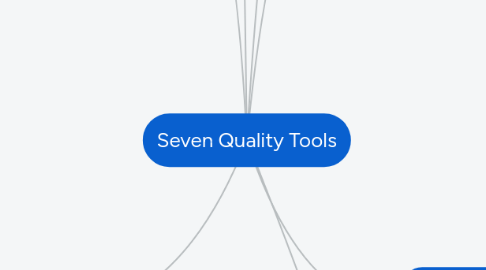
1. 1. Pareto Diagram
1.1. Description
1.1.1. It shows on a bar graph are more significant. Besides, it also known as 80/20 rule (approximately 80% problems are created by 20% of causes.
1.2. How to make a Pareto Diagram?
1.2.1. Arrange item in descending order of their individual contribution. Tabulate item according % of total & cumulative contribution of items. Draw x (items) and y-axis (contribution of items & cumulative items) Draw bars for y-axis Plot & connect points for cumulative contribution at the end of each item
2. 3. Check Sheets
2.1. Description
2.1.1. A structured, prepared form for collecting and analyzing data; a generic tool that can be adapted for a wide variety of purposes.
2.2. How to make a Check Sheets?
2.2.1. 1. Decide what event or problem will be observed. Develop operational definitions. 2. Decide when data will be collected and for how long. 3. Design the form. Set it up so that data can be recorded simply by making check marks or Xs or similar symbols and so that data do not have to be recopied for analysis. 4. Label all spaces on the form. 5. Test the check sheet for a short trial period to be sure it collects the appropriate data and is easy to use. 6. Each time the targeted event or problem occurs, record data on the check sheet.
3. 5. Control Charts
3.1. Description
3.1.1. Graphs used to study how a process changes over time. It contains upper limit line, average line and lower limit line to make sure the process in control.
3.2. How to make a Control Charts?
3.2.1. Choose the appropriate control chart for your data. Determine the appropriate time period for collecting and plotting data. Collect data, construct your chart and analyze the data. Look for “out-of-control signals” on the control chart. When one is identified, mark it on the chart and investigate the cause. Document how you investigated, what you learned, the cause and how it was corrected.
4. 7. Stratification (Flow Chart or Run Chart)
4.1. Description
4.1.1. Stratification is a technique used in combination with other data analysis tools. When data from a variety of sources or categories have been lumped together, the meaning of the data can be impossible to see. This technique separates the data so that patterns can be seen.
4.2. How to make a Stratification?
4.2.1. Before collecting data, consider which information about the sources of the data might have an effect on the results. Set up the data collection so that you collect that information as well. When plotting or graphing the collected data on a scatter diagram, control chart, histogram or other analysis tool, use different marks or colors to distinguish data from various sources. Data that are distinguished in this way are said to be “stratified.” Analyze the subsets of stratified data separately. For example, on a scatter diagram where data are stratified into data from source 1 and data from source 2, draw quadrants, count points and determine the critical value only for the data from source 1, then only for the data from source 2.
5. 2. Cause-and-Effect Diagram
5.1. Description
5.1.1. It also called Ishikawa or fish bone chart. It Identifies many possible causes for an effect or problem and sorts ideas into useful categories. 5 major cause are materials, machine, manpower, method and environment.
5.2. How to make a Cause-and-Effect Diagram?
5.2.1. Identify effect clearly. Identify the causes (fish head) Build the diagram (5 major cause in fish body part) Analyze the diagram (sub fish body part) & take corrective action Draw the effect box & the center line
6. 4. Histogram
6.1. Description
6.1.1. - The most commonly used graph for showing frequency distributions, or how often each different value in a set of data occurs.
6.2. How to make a histogram?
6.2.1. I) Establish an array II)Tabulate frequency of each value under same column III)Tabulate numerical value of frequency IV)Construct the histogram
7. 6. Scatter Diagrams
7.1. Description
7.1.1. It also called: scatter plot, X–Y graph The scatter diagram graphs pairs of numerical data, with one variable on each axis, to look for a relationship between them. If the variables are correlated, the points will fall along a line or curve. The better the correlation, the tighter the points will hug the line.
7.2. 6 types of Scatter Diagram
7.2.1. 6 types of Scatter Diagram -No correlation (points everywhere) -Strong positive linear correlation (points pack on the positive line) -Strong negative linear correlation (points pack on the negative line) -Week positive linear correlation (points are around the positive line but not pack) -Week negative linear correlation (point are around negative line but not pack) -Non-linear correlation (point are pack without a line, like a snake form)

